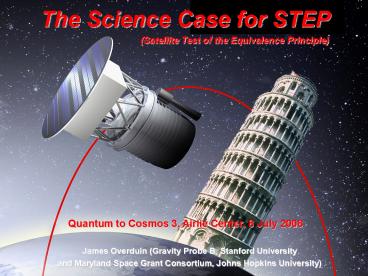The Science Case for STEP - PowerPoint PPT Presentation
Title:
The Science Case for STEP
Description:
Title: The Science Case for STEP Last modified by: James Overduin Document presentation format: Custom Other titles: Times New Roman Arial StarSymbol Symbol Default ... – PowerPoint PPT presentation
Number of Views:85
Avg rating:3.0/5.0
Title: The Science Case for STEP
1
The Science Case for STEP
(Satellite Test of the Equivalence Principle)
Quantum to Cosmos 3, Airlie Center, 8 July 2008
James Overduin (Gravity Probe B, Stanford
University and Maryland Space Grant Consortium,
Johns Hopkins University)
2
The equivalence principle
- Einstein's happiest thought (1907) the
effects of gravity can be locally - transformed away by accelerating along with
the test body
- I.e., gravitation acceleration
- But is this equation exact? Is gravity
perfectly geometrical?
3
Testing equivalence
- Test by dropping different kinds of test
materials in same gravitational field
4
STEP concept
- Essentially an orbiting version of Galileo's
drop-tower experiment
- More time for separation to build, and signal is
periodic
- Larger driving acceleration and quieter
seismic environment allow - for improvement of 5-6 orders of magnitude over
terrestrial tests
- Inherits key technologies from Gravity Probe B
drag-free control, - cryogenic SQUID readout, electrostatic
positioning system, others
5
Discovery potential
- STEP tests the foundation---not a
prediction---of Einstein's theory of - general relativity, which holds up half of
present-day physics
6
Crisis and unification in physics
- Einstein's geometrical theory of gravity based
on the Equivalence Principle - cannot be unified with the rest of physics (the
standard model)!
7
What to drop?
- heavy vs. light elements?
- baryons vs. leptons?
- different particle generations?
- matter vs. antimatter?
- fermions vs. bosons?
- matter vs. dark matter?
8
What might STEP find?
9
Importance of a null result
- a null result closes the door on new fields of
the kind generically predicted - by unified field theories, implying that a
gravity really is purely geometrical - and a more radical approach is required to
unify it with the standard model
10
A win-win experiment
- Unification generically requires the existence
of new fields
- We receive critical experimental guidance,
- whether EP violations are detected or not
11
Complementarity
Fundamental physics triangle
EP violations
- LHC may find indirect evidence for new fields
(missing-energy signature)
- SNAP may find direct evidence for new fields
(dynamical dark energy)
- only STEP can tell us how these fields interact
with everything else
12
Summary
- STEP tests foundations (not predictions)
- of our current theory of gravity
- Points the way toward unification of
- general relativity and the standard model
- of particle physics, regardless of what it finds
- Predictions for violations of the Equivalence
Principle fall within STEP's - grasp and probably only STEP's grasp
whether based on dimensional - arguments, specific theories, or generic
calculations involving scalar - fields (as hinted at by unified-field theories
and cosmology)
- STEP is complementary to high-energy particle
physics experiments - (LHC, ILC) and cosmological probes (SNAP, JDEM)

